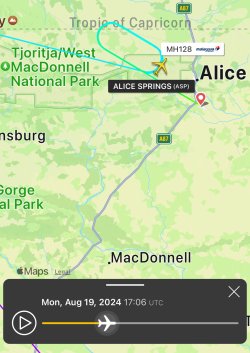- Joined
- Oct 13, 2013
- Posts
- 16,216
Why not just straight line the airflow?.
I'm sure laminar flow in jet engines is impossible due the accelerating nature of the flow via the compressor in front and turbine in the rear.maximize laminar airflow -
thanks but against that would it result in less thrust and maybe more complicated?. I suppose there must have been an overall benefit.less aerodynamic

Why not just straight line the airflow?.
I can see structural reasons for wanting the engine, and its thrust to be through the centre of the fuselage, rather than at the base of the fin. The fact that both versions exist in similar aircraft (Tristar vs DC-10) tells me that any differences are probably marginal.The 727 is similar. Always thought it was a "win some, lose some" engineering trade-off thing
GPS updating can be turned off, so I expect that will be happening much more in the future. I'm not sure that I believe the time could be reset by years, one would hope that there is some form of reasonableness check in any software...though we have seen some pretty poor implementations of software over the years. And a reset taking weeks? Surely they'd just pull the boxes, put new ones in, and any lengthy work could happen on the ground.Just saw this re GPS spoofing affecting coughpit systems relying on time. Mentions an aircraft from major western airline needing a 'manual reset' taking weeks
I know pilots are incredibly trained and professional so hope you’ll forgive this pop culture question: What’s the worst sound you can hear in the coughpit?
Every pilot will have a different answer. And many nasty things are hidden behind reasonably common noises. The master caution and its associated sounds goes off for a plethora of different reasons. But, how about a very large bang, with no immediately obvious cause.I know pilots are incredibly trained and professional so hope you’ll forgive this pop culture question: What’s the worst sound you can hear in the coughpit?
No, not really. A cabin or cargo fire is much worse than an engine fire.Is it the fire alarm?
Or 'too low, gear'.Whoop whoop pull up?
Well, you're not going to get directly involved, so it's a PITA, but that's all (for the pilots anyway).A flight attendant calling about a pax carrying on?
I can fly the jet without him.The co-pilot saying their last meal is disagreeing with them?
AFF Supporters can remove this and all advertisements
But, how about a very large bang, with no immediately obvious cause.
Haha.Perhaps when the FO's snoring wakes you up.
I watch them occasionally. An interesting pair. I think Mover is now a 737 FO, and Gonky a 320 Captain.On another note, there's a YouTube channel called the Mover and Gonky Show with two ex-US military pilots and now presumably, airline pilots who discuss military aviation and other stuff.
Tell, Richard, I’m sure he’d be interested. Me? No.Last night I watched one which featured a former RAF pilot. Hilarious stuff. It'd be great to see somone from here feature on the show. hint, hint.
No. That’s a configuration that is dead. Engines are generally the least of your problems anyway. EROPs incorporates many more systems than just propulsion. I think the last attempt at a filling the 3 engine niche was probably the A340, which was simply an A330 with two extra engines.Would TriJets have a role these days given the high performance and reliability of the twins? - say in the southern routes between SYD and JNB/SCL?
It would be the Pakistani controllers setting up the timing/spacing/altitude for entry to Afghanistan.QF1
What was the reason?

Looking at FR24, it's just done a small step climb from FL370 to FL380, and almost immediately thereafter starts to descend. So, that looks a lot like an engine failure, or at least something that's forced them to pull one engine back to idle. They wouldn't have sufficient power to stay up high on one, so you'd need the descent immediately.9M-MTJ (MH128 MEL-KUL, A330-300), diverted to ASP due to "engine issues" but then went into a 2hr hold before landing.
Umm... The ability to dump fuel is optional on many aircraft, and the A330 is one. But you can pick which aircraft have the capability by looking at the back of the flap track fairings, as the third one on each side has the dump nozzle. And looking at the pictures, this aircraft was fitted with it. So...not what I'd expect.Passenger reports say Pilots said needed to "burn fuel".
Alice is about 2,400 metres long, so it should be adequate for a 330 in normal circumstances. But, if they had an engine out, then the landing procedure would probably have them using less flap, which would mean more speed, and so the length might become marginal. It makes me wonder if Darwin might not have been a better choice.But 2hrs? And 3.5hrs after departure?
This is a comment from the CASA paperwork for Alice.Whats the procedure for an unscheduled landing at an airport outside of normal hours?

